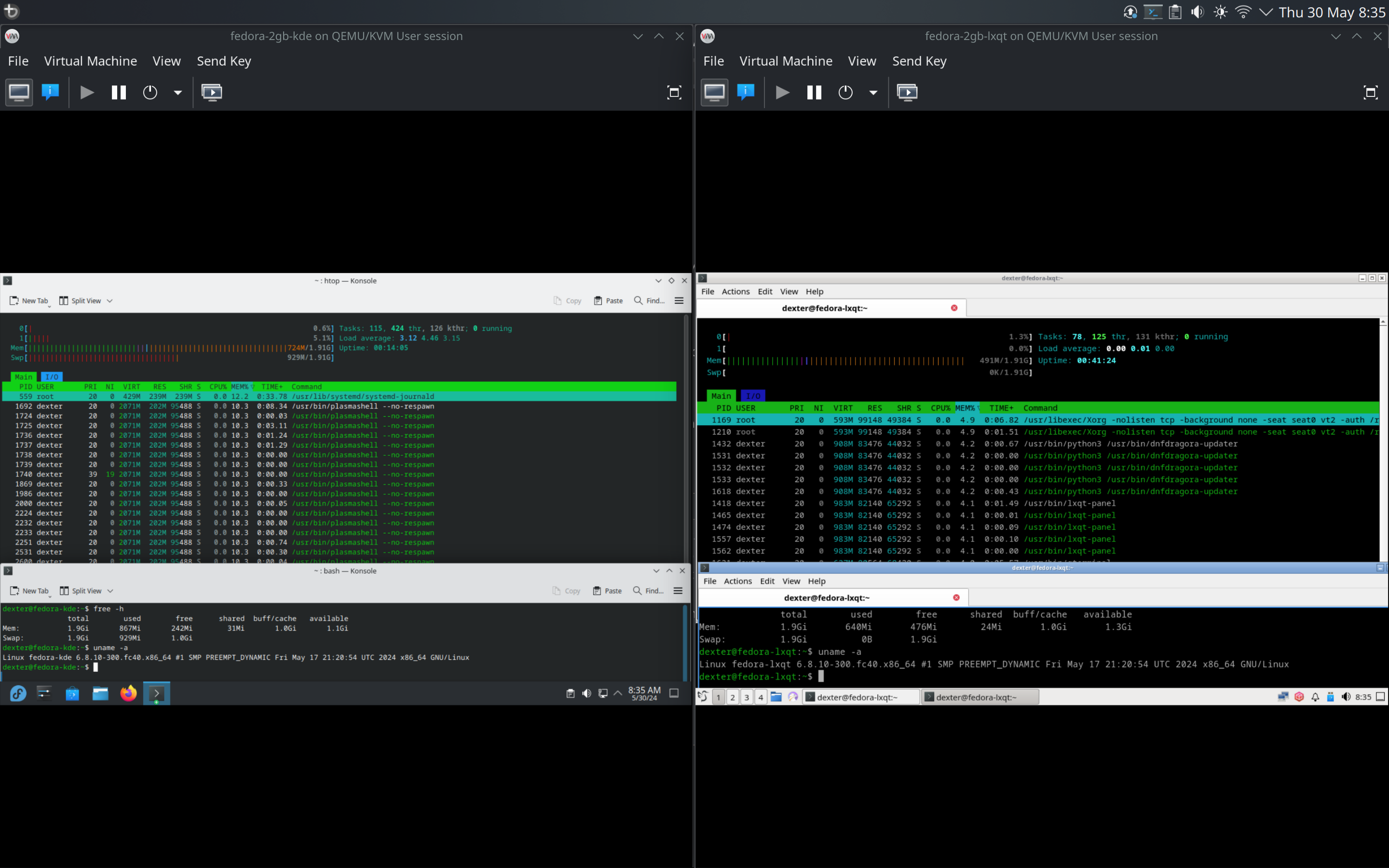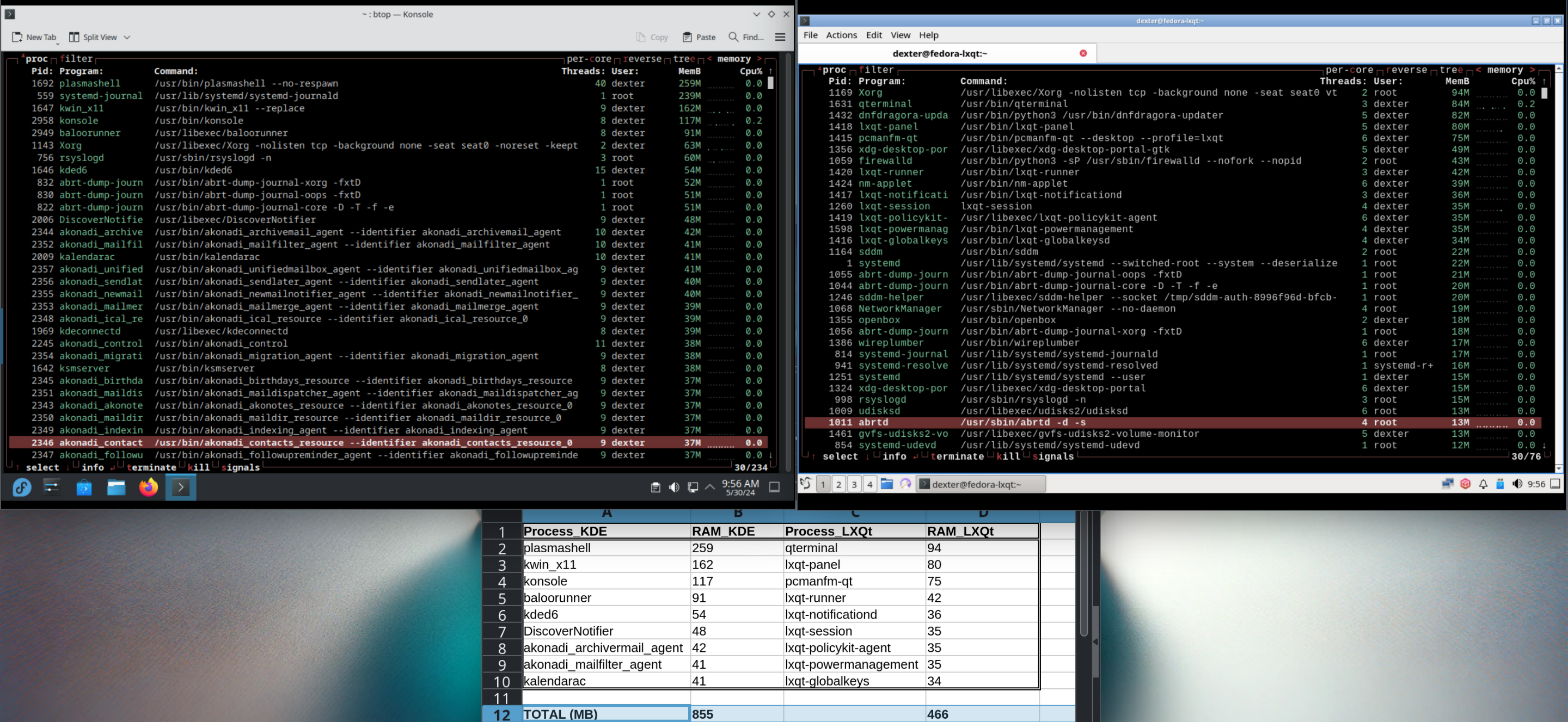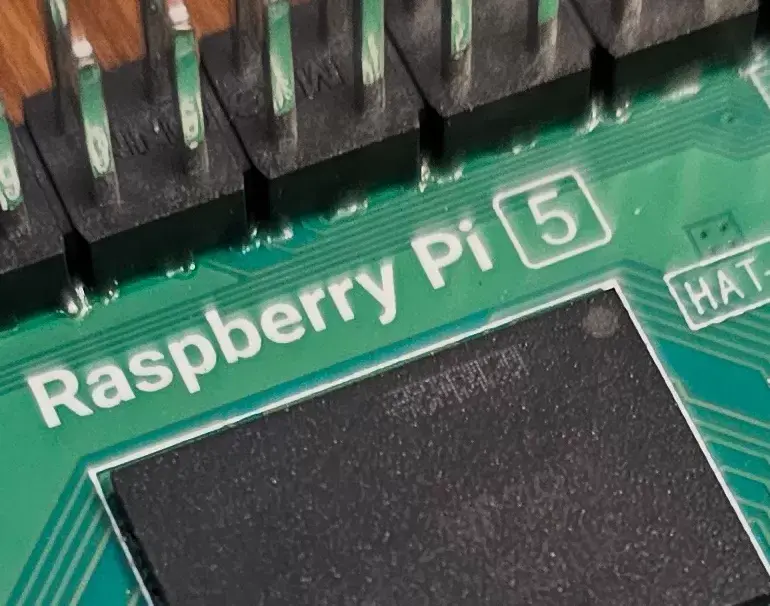- 5 Posts
- 125 Comments
You’re arguing semantics and that’s not the point I’m trying to argue here. Forget the term “Plasma”. I don’t really care about what the DE is branded as or what’s in “Plasma” the software package. When I say “KDE”, I mean the desktop + all the basic default/recommended apps that you’d see on a typical KDE installation, such as Dolphin, Konsole, Kate, Kalculator, Spectacle etc that’s part of the KDE project. IDK whether the apps I’ve mentioned are considered part of “Plasma” or not, but again, that’s not the point, I’m saying this is what I meant when I said “KDE” - and what most people would expect when they picture a “KDE” environment.
Anyways, I tested this myself on two identical VMs with 2GB RAM, one installed with Fedora 40 KDE, and another with Fedora 40 LXQt, both set to use X11 (because LXQt isn’t Wayland ready yet), both updated and running the latest kernel 6.8.10-300.fc40. I logged into the DEs, opened only two terminal windows and nothing else, ran, and ran
htop. The screenshot speaks for itself:
And when I tried disabling swap on both machines, the KDE machine was practically unusable, with only 53MB RAM remaining before it completely froze on me. Meanwhile, the LXQt one was still very much usable even without swap enabled.
I’d like to see you try running without swap and see how it fares. And if you think it’s unfair disabling swap on a 2GB machine - try installing LXQt yourself, disable swap and see for yourself how much more usable it is compared to KDE.
And this is why I say KDE is bloated and not suitable for old machines.
Edit: Also, check out the memory consumption listed by a user in this post: https://lemmy.nz/comment/9070317
Edit2: Here’s a screenshot of the top 30 processes on my test systems, side-by-side:

Of the above, I calculated the usage of the top 10 processes specific to each respective DE, and you can see that KDE’s memory usage is almost double that of LXQt. Had I counted all the DE-specific processes, it’d no doubt be a lot more than double.
Correct me if I’m wrong, but this #OptGreen project isn’t talking specifically about Plasma, is it? They don’t mention Plasma anywhere on the page they linked.
In any case, that’s irrelevant, also, I don’t doubt that KDE can’t run at all under the specs you mentioned - that’s not the issue. The question is, how much free/usable RAM do you actually have on that machine - let’s say with no apps open first, and with then check again with Konsole + Dolphin + KWrite/Kate open? And for fun, fire up Konqueror as well and check again.
Edit: Screenshots proving that what you’re saying is not correct:


I’m not talking specifically about Plasma, I’m talking about the “DE” part of KDE in general; and particularly in this context of repurposing and extending the life of old PCs.
I find it a bit ironic for KDE to be pushing this message, when it’s a heavy DE (relatively speaking) - it’s NOT what anyone would have in mind when when selecting a DE for an old PC.
For instance, take LXQt - run the default/recommended file browser, terminal and text editor, and compare it with KDE + equivalents - you’d see a significant difference in resource consumption. On a system with low RAM, that extra bit of free memory makes a big difference, as it could mean avoiding the penalty hit of the swap file, which you’d invariably run into as soon as you fire up a modern Web browser. So it’s vital that the DE use as little resources as possible on such a machine.
So, are there any plans to reduce the bloat in KDE, maybe even make a lightweight version (like LXQt) that’s suitable for older PCs with limited resources?

 52·1 month ago
52·1 month agoIn the footnotes they mention GPT-3.5. Their argument for not testing 4 was because it was paid, and so most users would be using 3.5 - which is already factually incorrect now because the new GPT-4o (which they don’t even mention) is now free. Finally, they didn’t mention GPT-4 Turbo either, which is even better at coding compared to 4.
You’ll need to bind a hotkey to a third-party tool such as ydotool.
Eg using ydotool, the command would be
ydotool click 0xC1

 2·2 months ago
2·2 months agoThis is a general tech community, mostly centered around news and end-user technology discussions, so it’s very unlikely you’ll get an answer here. Might want to try asking on Reddit or some dedicated Datto/Connectwise forum.
Well I haven’t used Plasma Mobile or any of the apps you’ve mentioned, so it’d be nice to see what it all looks like! (and I don’t have a device I can try it on either, unless I can get it working with Termux + Termux-X11?)
Nice writeup, but it would’ve been nice if you added some screenshots or a short video of your setup!

 4·2 months ago
4·2 months agoConsidering that predicting the next word from context is the one thing LLMs are really good at, I just don’t understand how none of these developments have found their way into predictive keyboards.
The problem is that LLMs require a considerable amount of computing power to run, unlike the simple markov chain predictions that keyboards use. You could use a cloud-based service like ChatGPT or something, but most people wouldn’t want their keyboards to send all their keystrokes to a remote server… and even if they didn’t know or care, the response time wouldn’t be good enough for real-time predictions.
Now smartphone SoC makers like Qualcomm have started adding NPUs (neural processing units) with their latest chips (such as the SD8 Gen 3, featured in the most recent flagship phones), but it’s going to take a while before devices with NPUs become commonplace, and it’ll take a while for developers to start making/updating apps that can make use of it.
But yeah the good news is that it is coming, it’s only a matter of “when” - I suspect it won’t be long before the likes of SwiftKey start to take advantage of this.

 3·2 months ago
3·2 months agoThe bypassnro command still works though. Installed 23H2 in a VM yesterday and it worked fine.

 2·3 months ago
2·3 months agoYou seem to know your stuff, so I have a question - growing up, we had a monochrome CRT monitor with a sepia tint to it, and I’ve been looking for such a monitor for a long time, with no luck. Most of the mono monitors I’ve come across online are either greyscale, amber or green. I can’t find a sepia tinted one. I know my monitor wasn’t unique since I clearly remember some of my friends having similar sepia tinted monitors, so I’m sure mine wasn’t a glitchy or something… but I can’t seem to find any evidence such a monitor even existed. Any ideas if this was really a thing, or have I somehow mixed up the colors in my memories?!

 181·3 months ago
181·3 months agoPasswords are used in more places than just browsers though. If there wasn’t any need for a dedicated app, why did they bother making one for Windows?
But personally, I dislike Bitwarden as well. I prefer KeepassXC instead, as it works fully offline and I don’t need to depend on a cloud-based provider (or spin up a server). The best part about KeepassXC is that it supports auto-typing credentials, so you don’t need to copy-paste - and it works across a multitude of apps, such as remote desktop / terminal sessions.

 418·3 months ago
418·3 months agoall devices
Lies, there’s no Linux app yet. As usual, Proton Inc continues to treat Linux users as third-class citizens, all whilst claiming they care about privacy and security.
Edit: They don’t even have a macOS app yet lol.


 2·3 months ago
2·3 months agoIt was big among the netsec/sysadmin crowd too, it was the first place you’d hear of 0-days in the wild, or whether a popular site/service was down.

 5·4 months ago
5·4 months agoThe only Keen I know of (and acknowledge) is the Commander:


 2·4 months ago
2·4 months agoSpeaking of German privacy tools… Win10privacy is still being updated from the looks of it, so that could be an option too.






I’m not moving any goalposts. You’re the one arguing about the semantics around “Plasma”, and I keep saying that’s irrelevant.
Refer back to my original comment which was, and I quote:
To clarify, here I was:
The ENTIRE point of my argument was the KDE isn’t really ideal RELATIVELY, for older PCs with limited resources, and I’m using LXQt here are a reference.
In a subsequent test, here’s a direct apples-to-apples(ish) component comparison:
plasmashellwas sitting at 250MB btw in this instance btw.The numbers speak for themselves - no one in their right minds would consider KDE (or
plasmashell, since you want to be pedantic) to be “light”, in RELATION to an older PC with limited resources - which btw, was the premise of my entire argument. Of course KDE orplasmashellmight be considered “light” on a modern system, but not an old PC with 2GB RAM. Whether something is considered light or bloated is always relative, and in this instance, it’s obvious to anyone that KDE/plasmashellisn’t “light”.